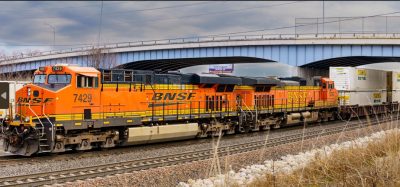A new link in the European chain
Posted: 6 February 2007 | | No comments yet
In the last quarter of a century, high-speed rail links have revolutionised domestic and international traffic. On 3 July 2006, almost exactly 25 years after the first high-speed train was placed in service between Paris and Lyons, work began on the Eastern branch of the Rhine-Rhone high-speed line between Dijon in Burgundy and Mulhouse in Alsace. With this new 140km line, Réseau Ferré de France (RFF) is about to notch up a further milestone in the development of the French and European high-speed network.
In the last quarter of a century, high-speed rail links have revolutionised domestic and international traffic. On 3 July 2006, almost exactly 25 years after the first high-speed train was placed in service between Paris and Lyons, work began on the Eastern branch of the Rhine-Rhone high-speed line between Dijon in Burgundy and Mulhouse in Alsace. With this new 140km line, Réseau Ferré de France (RFF) is about to notch up a further milestone in the development of the French and European high-speed network.
In the last quarter of a century, high-speed rail links have revolutionised domestic and international traffic. On 3 July 2006, almost exactly 25 years after the first high-speed train was placed in service between Paris and Lyons, work began on the Eastern branch of the Rhine-Rhone high-speed line between Dijon in Burgundy and Mulhouse in Alsace. With this new 140km line, Réseau Ferré de France (RFF) is about to notch up a further milestone in the development of the French and European high-speed network.
A line right in the heart of Europe
With its three complementary branches, the Rhine-Rhone high-speed line will provide a vital link between the North and South of Europe. The Eastern branch (from Dijon to Mulhouse) is the first section that will be built. The Western branch (through the Dijon region) and Southern branch (connection with the Lyons area) are currently in the study phase. The project as a whole is masterminded and coordinated by Réseau Ferré de France, the owner and manager of the French railway network since 1997.
The route for the line has been chosen so that it will link Eastern France with major economic and population centres in the Rhine Basin and Benelux countries. It will also help connect these centres with urban and economic clusters on the Mediterranean Arc. It should therefore serve to further secure France’s position on a continent increasingly gravitating towards the East.
The project has the backing of the Swiss Federation, which will enjoy the benefits of the new and improved link. The line has also been classified as a “priority corridor” by the European Union in relation to its European transport networks. These two factors alone speak volumes for the community interest of the project.
Injecting new life into the regions
This first-ever province-to-province high-speed rail link will give an enormous boost to inter-regional services. With the first section of the Eastern branch alone, journey times will be slashed on many routes between Eastern and Western France (from the Paris region to Switzerland) and with regions in the South of France.
Territorial ambitions
The high-speed line project, which was first launched in 1993, has attracted the support of all the local political players, who have been greatly instrumental in bringing it to fruition.
Unlike all the other such lines currently in existence or under construction, which all transit via Paris or its suburbs, the Rhine-Rhone high-speed line will be the first to link two provincial towns. This is one of the project’s most unusual facets.
The unfailing support of those with regional decision-making authority throughout the design phase has been a vital factor, directly or indirectly, in the project’s success. This support even extends to substantial regional participation in the total €2.3 billion bill for completing the line.
Priority for dialogue and local outreach
To cater to the regional dimension of this project, Réseau Ferré de France has made a conscious decision to foster dialogue and exchange. From the outset, the designers of the project were primed to adapt line concepts to the different sites along its length and to choose a route that would have the least possible effect on the local habitat, on the environment and local farming community.
Given the novelty of the new line as the first province-to-province link of its kind in the French rail transport organisation, RFF also had to find suitably adapted management structures for the project. For the past 10 years and more, project studies have been coordinated and supervised at local level. By opting for teams familiar with the region and in close contact with people in the field, it has been easier to explain RFF’s proposals to the local population. A project team has been working on the spot for several years and is in direct contact with the local residents, mayors and community associations affected by the project. Its goal is to maintain communications channels open at all times.
Throughout the project, Réseau Ferré de France has sought to maintain and develop its network of contacts. Today it is using the same approach in its dealings with the companies carrying out construction work. In the last five years in particular, more than 100 public hearings have been staged in the many localities affected by the line.
In addition, by working closely with the government departments concerned it has been possible to ensure full compliance with the regulations and procedures for projects of this scale: consultations, environmental considerations, land acquisitions, etc.
A 5-year site, 6,000 jobs per year
Civil engineering work officially began in July 2006. From 2007, the site will be in full operation and will be the biggest of its kind in France. The high-speed line will create a total of some 6,000 jobs per year. At the moment, more than 1,000 people are already working in connection with the site.
Earthworks activities have been divided into some 15 tranches for a maximum of local control, in line with the approach adopted by RFF since project inception. Since the worksite opened in July it has been extended over more than half the ultimate length. The last contracts will be awarded in the first half of 2007 and the line itself should be commissioned at the end of 2011.
Social innovation
For maximum impact, Réseau Ferré de France has decided to opt for an innovative approach to the task of staffing its worksites. Agreements have been signed with the companies awarded the public works contracts whereby 7% of all hours worked are to be earmarked for the chronically unemployed. The first results are already noticeable. Several agreements have been signed and some 80 jobseekers have found employment related to the project.
Expected benefits
Not only will the new line slash journey times and improve travel within France and the rest of Europe, but its biggest impact will be on passenger traffic. An estimated 1.1 million passengers per year are expected to pass through each of the two new stations to be built. This is a net increase over current traffic figures and is certain to bring a welcome boost to economic development.
Rail, the environment-friendly mode
In terms of sustainable development, the railway is without a doubt the mode of the future. Every day thousands of vehicles pass through our regions, in particular on the roads. Railways offer a viable alternative to the growing problem of road traffic congestion.
‘La Savoureuse’ viaduct: an integral part of the landscape
The ‘La Savoureuse’ viaduct will be the longest on the future Rhine-Rhone high-speed line. It will cross the Savoureuse Valley between Montbéliard and Belfort, spanning the A36 motorway, an A road, a B road, a river and a canal. Particular care has been given to its design to make it a feature of the valley. An international team made up of Jean Muller International, Wilkinson Eyre and Alfred Peter was commissioned to this end.
The project concerns a 1,300 metre length of line comprising not only the 816 metre long viaduct itself, but also the mouth of the cutting carved into the flanks of the valley to the West. Despite route alignment constraints imposed by the choice of 350 km/h running speeds and the need for a structure capable of coping with railway loads, it was important that the new infrastructure should fit smoothly into the already dense fabric of the valley.
The challenge consisted of designing a railway viaduct that, although not rising very high above the ground, would not look too ungainly, would have a deck in proportion to its piers and would not appear to form a concrete wall slicing through the landscape when viewed from an oblique angle.
Simplicity, symmetry and harmony were therefore the essential ingredients of a structure reflecting the pattern of forces at work. The resulting viaduct will consist of a series of relatively short steel spans seamlessly supporting a track of long welded rails. Resting on one box girder each side, the deck will form a smooth, unbroken and elegant line. It will stand on distinctive tetrapod piles whose profiles will be sculptured across and along its length and which will have larger or smaller concrete pads at their base to cater to differences in the natural height of the ground.
The design approach to the project targeted areas such as:
- A functional viaduct of robust construction, giving the impression of lightness through the relatively low elevation of a deck blending harmoniously into the natural beauty of the site
- A clear and simple concept based on sharply geometric piers of varying heights to allow for the differences in ground and railway track altitude
- A easily recognisable shape consisting of double ‘V’ shaped piers and a long slender elegant silhouette brought into sharp focus at night by the upwards beam of the lights nestling at the centre of the tetrapod piles
- A spectacular modern viaduct of contemporary design making a bold statement against the valley backdrop
The result will be an architectural masterpiece with proportions to match those of the valley itself and using technology to ensure visual integration into the site. The structure will also respect the principles of architectural design, namely elegant lines, extraordinary attention to detail and intrinsic ‘technological beauty’.
About the author
Marc Svetchine spent most of his career working for the French Ministry of Public Works before joining Réseau Ferré de France (RFF) in February 2002 as Regional Director for Burgundy and Franche-Comté based in Besançon. It is in this capacity that he is responsible for the Rhine-Rhone high-speed line project.








